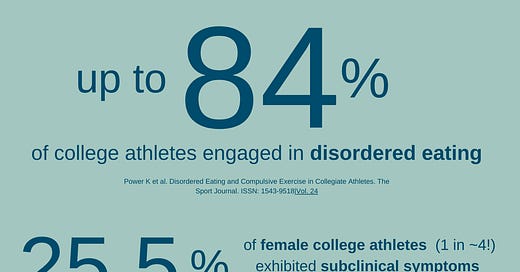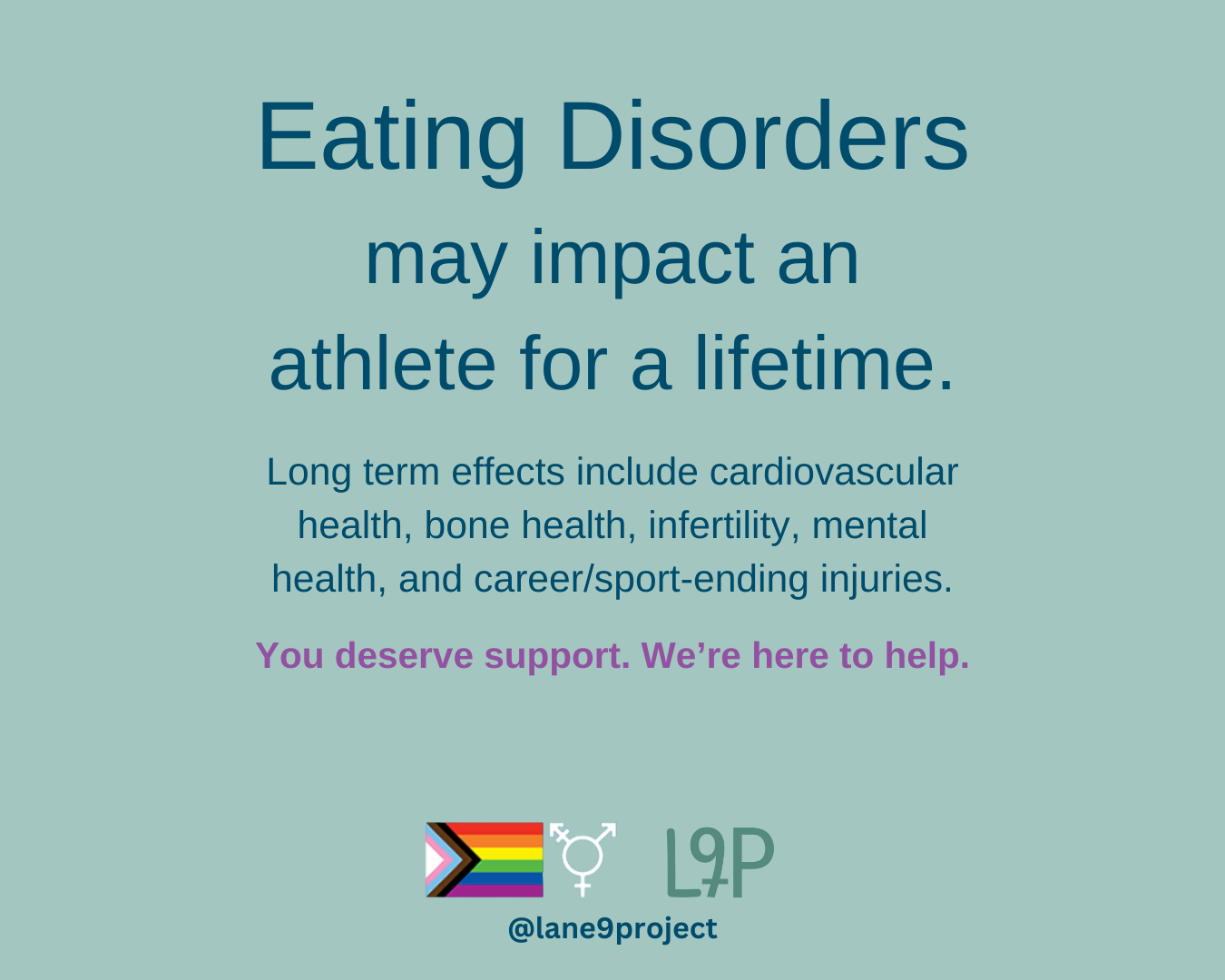Eating disorders are not rare.
And it doesn't have to be "full blown" for you to need, or benefit from, support.
Lane 9 was created out of our own frustrations. It was formed between runners who met each other, realized they had struggled with amenorrhea and disordered eating and a massive knowledge gap from clinicians who interacted with them over the years, not expressing concern— flagging neither missing periods nor weight changes as an issue to look into.
We wondered, Why don’t a variety of clinicians know more about this?. We asked ourselves, what could WE do about that? And we started by sharing our stories.
Since then (2017), we’ve heard and shared so many stories of eating disorders, disordered eating, and body image struggles within sports—and as humans in the world!—and one thing is clear to us through both these anecdotes and the research:
Eating disorders are not rare.
They’re not one in a thousand, or one in a hundred, or even one in fifty. They could be as common as ONE in FOUR athletes. You have a team of 24 athletes, six of them are likely to have an eating disorder (ED). A team of 8, two eating disorders. It IS happening on your teams, in your friend groups. If it’s not you, it is definitely someone you know.
They’re not rare, they’re just commonly ignored.
They’re not rare, they’re just stigmatized.
They’re not rare, we’re just not aware of how many people are struggling1.
This week—Eating Disorder Awareness Week—once a year, we work extra hard to change that. But every week, all year, we’re working on helping coaches, athletes, and fellow clinicians to learn more about eating disorders.
This week, and every week, we’re connecting with the clinicians who are informed on these issues, building out a collective of providers and coaches who are ready to support you, any athlete, in any sport, and any season of life, through your recovery.
Regardless of whether it’s “just” disordered or fits into a neat diagnostic box, there are negative health and sport performance effects.
Up to 84% of college athletes reported engaging in disordered eating patterns.
What does that mean? It may mean restrictive eating, skipping meals or snacks, angst around certain foods or food environments (like a restaurant), avoiding social situations because of this angst around food, restricting certain types of foods or food groups in the absence of an allergy or intolerance, and/or feeling preoccupied with food planning and food thoughts.
The line between disordered eating and an eating disorder is drawn through diagnostic criteria outlined for clinicians. But in reality, it’s blurry. And regardless of whether it’s “just” disordered or fits into a neat diagnostic box, there are negative health and sport performance effects.
Around 1 in 4 athletes will struggle with this.
And it could impact them for the rest of their life. When left untreated, not taken seriously, lingering for years if not decades, disordered eating and eating disorders leave the body malnourished, and it matters.
We see the impact on bone health, digestive health, cardiovascular health, reproductive health, immune health, and last but certainly not least, mental health.
Eating disorder treatment requires a team.
It’s not just one provider, or one coach, who will carry an athlete/person through treating REDs, disordered eating, or an eating disorder. It’s a team sport! It may start with a therapist and/or dietitian, and will include medical providers as well as physical therapists (most likely, but not in all cases). This is true in and outside of athletics, and we want to note that athlete-specific care matters. Having a team of clinicians and coaches that understand how important and valuable sports are for any one person matters. Treating the athlete and the person matters.
That’s why we built out the Lane 9 Directory to include all of those disciplines. So that an athlete/human who is struggling only needs to go to one place to build their care team. Right here.
Last but not least…
…we’ll ask you to stop wondering if the disordered eating is a “full blown” eating disorder.
We hear this term (“full blown2 eating disorder”) all the time in our stories and conversations. Subconsciously or not, it’s a way that folks diminish their experience, they wonder if it was or is “bad enough” to warrant support.
So we’ll just say, YES, you will benefit from the support of a dietitian, and/or therapist, and/or DPT, and/or medical provider who sees disordered eating, REDs, and eating disorders as something worth treating, because they are. They impact you, and your health, and that matters. “Full blown” or not.
If you have questions about any of this, want to bring Lane 9 into your team or training group or class, get in touch with us here.
On the Lane 9 Podcast this week (EDAW)
First, we took it back to the origin story of Lane 9, how Alexis and I (Heather) met, and why we started Lane 9. Tune in here, “Why we started Lane 9, 8 years ago”.
And we caught up with Amelia Boone—who somehow found and supported Lane 9 right from the beginning, and has had many conversations with us along the journey of her experience, going back to ED treatment in her mid-30s. Episode 39, Amelia Boone is back and talking about how she feels after a full year (2024) of no racing, figuring out a difficult injury, and finding new ways to express creativity and self outside of running.
Lane 9 Resources
We offer team/group workshops,
individualized Run Coaching for those with a history of REDs and ED
and a Membership for clinicians that includes events like Journal Clubs, Book Clubs, and Case Consults. Check it out here.
If you want to share your story with fellow Lane 9 athletes, contact us!
Our work focuses on the impacts and prevalence of eating disorders in sport, but of course eating disorders impact anyone. Anorexia Nervosa is the deadliest clinical mental health disorder, with the highest rate of mortality. The research is limited in studying marginalized communities, including but not limited to BIPoC and LGBTQIA+ communities and individuals.
Most people who say this are implying that in their experience, they may not have met the diagnostic criteria for a clinical eating disorder. But that clinical box, that list decided by a group of people some number of years ago, wasn’t meant to dismiss very real experiences. It can be used as a tool, but it’s not the end all be all judgment of who deserves help. You deserve help.






